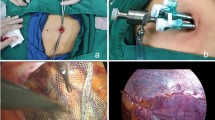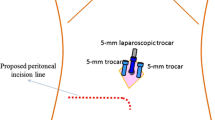Abstract
Objective
The aim of this pilot study is to assess the safety, feasibility, and short-term outcomes of single-incision laparoscopic trans-abdominal preperitoneal (TAPP) mesh hernioplasty using conventional laparoscopic instruments.
Methods
During a 3-month study period, data from all consecutive patients referred for inguinal hernia repair to the general and minimally invasive surgery unit of our institution who agreed to undergo single-incision TAPP mesh hernioplasty were included in the prospective study. Outcome measures included completion rate of the attempted procedure, operative time, length of hospital stay, postoperative pain, and assessment of complications. Follow-up was done for 3 months.
Result
Fifteen patients completed our protocol. Two patients had bilateral inguinal hernias while all other patients had unilateral hernia. Two patients had sliding hernia on the left side which had sigmoid colon as content. None of the patients required any additional port. There were no intraoperative complications.
Conclusions
The concept of laparoscopic single-incision surgery is an attractive and understandable innovation as laparoscopic surgery has become more commonplace. Based on our experience, we believe that the procedure is feasible without additional risk. Cosmetic benefit is clear; however, beyond the actual outcome with respect to postoperative pain and long-term complications, needs to be evaluated and compared to standard laparoscopic TAPP mesh hernioplasty.


Similar content being viewed by others
References
Reddick EJ, Olsen DO, Daniell J, Saye WB, McKernan B, Miller W, Hoback M (1989) Laparoscopic laser cholecystectomy. Laser Med Surg News Adv 7:38–40
Payne JH Jr, Grininger LM, Izawa MT, Podoll EF, Lindahl RKT, Balfour J (1994) Laparoscopic or open inguinal herniorraphy? a randomized prospective study. Arch Surg 129:973–981
Tschudi J, Wagner M, Klaiber CH (1996) Controlled multicentre trial of laparoscopic transabdominal preperitoneal hernioplasty vs shouldice herniorraphy. Surg Endosc 10:845–847
Fitzgibbons RJ, Salerno GM, Filipi CJ, Hunter WJ, Watson P (1994) Laparoscopic intraperitoneal onlay mesh technique for repair of an indirect inguinal hernia. Ann Surg 219(2):144–156
Takata MC, Duh QY (2008) Laparoscopic inguinal hernia repair. Surg Clin N Am 88(1):157–178
Esposito C (1998) One trocar appendectomy in pediatric surgery. Surg Endosc 12:177–178
Puskin G, Rajpal S (1999) Transumbilical laparoscopic cholecystectomy utilizes no incision outside the umbilicus. J Laparoendosc Adv Surg Tech A 9:361–364
Hirano D, Minei S, Yamaguchi K, Yoshikawa T, Hachiya T, Yoshida T, Ishida H, Takimoto Y et al (2005) Retroperitoneoscopy for adrenal tumors via a single large port. J Endourol 19:788–792
Grant AM (2002) Laparoscopic versus open groin hernia repair: meta analysis of randomized trial based on individual patient data. Hernia 6:2–10
The MRC laparoscopic groin hernia trial group (1999) Laparoscopic versus open repair of groin hernia: a randomized comparison. Lancet 354:185–190
Douek M, Smith G, Oshowo A, Stoker M, Wellwood JM (2003) Prospective randomized controlled trial of laparoscopic versus open inguinal hernia mesh repair: five years follow up. BMJ 326:1012–1013
Prabal Roy, Anushtup De (2010) Transumbilical multiple-port laparoscopic cholecystectomy (TUMP-LC): a prospective analysis of 50 initial patients. J Laparoendosc Adv Surg Tech 20(3):211–217
Rehman SH, John BJ (2009) Single-incision laparoscopic trans-abdominal pre-peritoneal mesh hernia repair: a feasible approach. Hernia, doi:10.1007/s10029-009-0550-x
Jacob BP, Tong W, Reiner M, Vine A, Katz LB (2009) Single incision total extraperitoneal (One SITE) laparoscopic inguinal hernia repair using a single access port device. Hernia 13:571–572
Bucher P, Pugin F, Morel P Single port totally extraperitoneal laparoscopic inguinal hernia repair. Hernia, doi:10.1007/s10029-009-0564-4
Author information
Authors and Affiliations
Corresponding author
Rights and permissions
About this article
Cite this article
Roy, P., De, A. Single-incision laparoscopic TAPP mesh hernioplasty using conventional instruments: an evolving technique. Langenbecks Arch Surg 395, 1157–1160 (2010). https://doi.org/10.1007/s00423-010-0656-8
Received:
Accepted:
Published:
Issue Date:
DOI: https://doi.org/10.1007/s00423-010-0656-8




